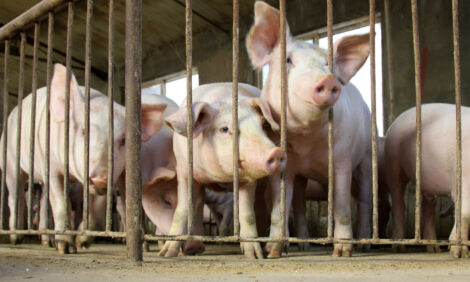



CME: Negative Factors Drive Hog Price Declines
US - It doesn’t matter what factor you pick these days, they are virtually all negative for hog prices, write Steve Meyer and Len Steiner.This week’s selloff has taken every contract through October to contract life low closes and every contract from December through next April to at least trade at contract life lows.
The weekly chart, shown below (see full report) was within pennies of its low the week of February 13 and that level was the lowest for Lean Hogs futures since November 2009 during the recovery from the H1N1/Swine Flu debacle.
We are taught that prices are determined by supply and demand but there is also the issue of market position and who holds the power in the market place at any given time. We don’t believe either supply or demand justify the price declines see since the end of 2014. But the relative positions of buyers and sellers explains a lot!
Consider that one set of buyers was basically shut out of the US market by the port slowdown. It doesn’t matter what demand looked like in Asian markets. US product could not be supplied in adequate quantities to meet that demand due to the bottleneck.
Part of the product that should have been flowing to Asia backed up on the domestic market, pu?ng domestic buyers in the driver’s seat. And thus began the decline. Economic agents are charged only with doing what is in their own self?interest and, clearly, the course of action for US pork buyers was to sit on their hands and let those extra pounds of product extract their toll.
Wholesale prices started downward and buyers have been hand to mouth ever since. Packers saw margins declining and began to drop hog bids but instead of slowing the flow of animals, slaughter rates increased!
The December Hogs and Pigs report told us that hog numbers would grow in 2015 but that the Q1 growth would be modest (1-2 per cent). But lower hog prices created a short?run incentive to get hogs sold — just the opposite of what we witnessed last spring when surging hog prices cause marketing delays.
With much lower than expected piglet losses from PEDv and finishing barns full of very large hogs, producers found themselves in a bind that forced hogs to town at a faster than expected pace.
The higher slaughter numbers have added to product availability, putting packers and producers at an even larger disadvantage to buyers.
But do this year’s slaughter levels mean the December report was wrong? Year to date slaughter based on weekly data was 907,000 head above last year’s pace through last week. Over the same period, the average weight of barrows and gilts reported under the mandatory price reporting system (ie. the “top” hogs that are a barometer of currentness in the hog market) has fallen by 3.1 pounds.
To drop weights that much requires pulling 1.5 to 1.7 days’ worth of slaughter forward. At 430,000 per day, this reduction in weights explains 645,000 to 731,000 head of the total growth in slaughter, meaning the December report may not have been far off in its suggested Q1 supplies. Slaughter weights have been additive to pork production so far this year but that is likely to change this week and weights could run well below year ago levels through the summer, reducing production relative to slaughter.
The lower than expected PEDv losses will indeed add to supplies this summer and fall but even if litter rates return to pre-PEDv levels, hog supplies should be within two per cent or so of 2013 levels when summer hogs peaked at over $100/cwt. Why would the futures markets have such large discounts based on those changes?
Well, futures markets will do what futures markets do but we think there are two issues. First, the port backlog will not disappear any time soon. Further, this disruption sent many Asian buyers to other suppliers and US sellers will not be able to re-earn that business overnight meaning the impact of that little showdown could have a long tail.
Second, the dollar continues to rise and has enjoyed one of its best runs in years the past two weeks, challenging the 100 level on the Dollar Index. As can be seen above, the dollar’s strength relative to the yen has kept tenderloin prices in yen near their highs of last fall even though domestic prices have fallen sharply.
The difference for butt prices is not as dramatic but Japanese buyers have certainly not benefitted as much from price declines as have domestic buyers. Maybe even more telling is that the average by product value per head has dropped from $29 last July to just $16 the week of March 7. By-products are driven by exports and the stronger dollar and port situation have taken their toll, reducing the important contribution that these items make to hog values.







